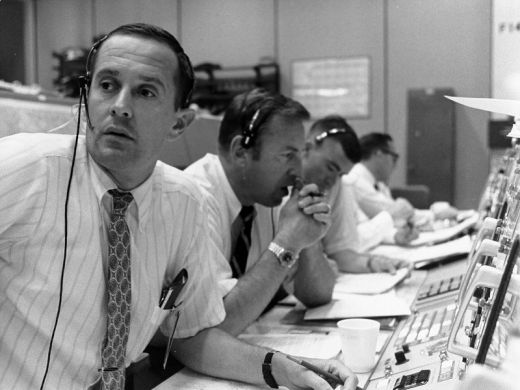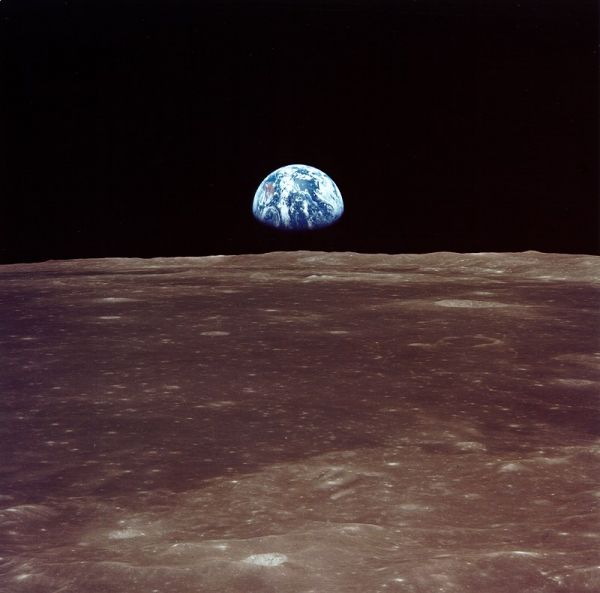The Eagle - the lunar landing module of Apollo 11, almost collided with a rock field. At NASA, they recreate the moments of tension

July 20, 1969. The day began on the far side of the moon. Armstrong Aldrin and third crew member Mike Collins flew the spacecraft 100 km above the scarred lunar desert. No one from Earth can see the far side of the Moon. Even today it remains a mysterious area, but astronauts Neil Armstrong and Buzz Aldrin didn't have time for a tourist tour. Collins pressed a button, set off a series of ignitions and the spaceship split in two. Half of it was called Columbia and Collins stayed in it, this half was meant to stay on track. The second half - the eagle (or eagle according to several versions), whirled over the horizon towards the calm sea on the visible side of the moon.
"You have permission to go out" said from Houston in connection, and the Eagle's engine was ignited powerfully. The spacecraft, shaped like an insect, was so fragile that a child could punch a hole in their golden outer shell. The Jagged Moonstones can deal more damage. So when Armstrong saw that the computer was guiding him into a rock field, he rushed to take command. The eagle was thrown forward and passed over the rocks.
Meanwhile, a loud alarm rang in the background. Software alarm, Armstrong announced, reading 1202. The code was so rare no one knew what it meant. Do they have to abandon, are they allowed to land. What is? Ask.
In Houston a young engineer named Steve Balls provided the answer. The radar guidance system 'wobbled' because the computer had too many interferences. "No problem, we got you," Houston said on the radio. "We confirm receipt of the information about the alarm."

And they continued. In any case, things did not go as smoothly as they should. The Sea of Tranquility was supposed to be smooth, but it didn't look so smooth on the Eagle's deck. Armstrong scanned the rocky sea looking for a good place to land. "60 seconds" they said on the radio from Houston. "30 seconds", shouted the telemetry data in Houston. Very quickly, too quickly, the spaceship could run out of fuel.
Someone later quoted that "the guys in the control room turned blue" when Armstrong announced "I found a good point". As for Armstrong, his heart once beat 156 beats per minute according to the biosensors. The fuel gauge showed only 5.6% when the eagle finally settled on the calm sea floor.
Houston (with a sigh of relief): "We sense you're down, Eagle."
Armstrong (coldly): "Houston, here is the base of peace. The Eagle Has Landed."
To continue the series on the 40th anniversary of the moon landing

7 תגובות
Wow, this must be an amazing experience!
To travel to space to stand on the beautiful lunar soil I wish I could fly to space I'm sure the life of those astronauts was not so boring they were the first people to be on the moon and see the moon and stand on it and see the earth from afar! I wish I could do that.
The previous thank you was intended for Michael's explanation.
Ami, I didn't write "not exciting", I wrote "a little less exciting". I see no problem with this wording. (And the fact that NASA has been rolling the fuel story for forty years, probably because it actually adds a lot to the tension element.)
And on the same topic: admit that NASA's admission that they "lost the original film" of the landing is a bit encouraging to the conspiracy theories on the subject. ) I don't support the conspiracy theory, but if this theory ever needed "fuel", then NASA provided it with at least 5.6% by "losing the original tape".
Shabbat Shalom again everyone.
95-5 sounds a bit extreme to me, but I don't understand the field, so I will have to accept your explanation as it is.
Thank you and Shabbat Shalom.
cedar,
Even if there was no fuel problem at all - the story was still exciting
cedar:
I don't know the facts, but the story makes sense.
At takeoff - all you have to do is take off at the right moment to join the mother spacecraft while on landing it is necessary to navigate (and it turned out that it was more necessary than expected) to find a good place to land.
During the entire navigation, the engines must be turned on quite a lot in order not to fall (in the absence of an atmosphere, the moon does not have the possibility to float and rely on the lifting force as they do on Earth).
I've heard this story before, and one detail doesn't add up to me...
5.6% of the fuel is enough to take off and navigate back to the spaceship hovering above? That is, it took 94.4% to land, but 5.6% was enough to detach from the moon and return to "Columbia"?
5.6% of the entire container - doesn't make sense to me. (Perhaps only 5.6% of the part of the fuel intended for the landing is left, without using the other part intended for the return phase - which also has a certain reserve, and then the story sounds a little less exciting.)